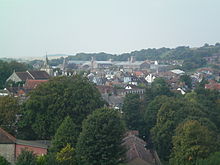HM Prison Lewes

Lewes Prison seen from the castle
|
|
| Location | Lewes, East Sussex |
|---|---|
| Security class | Adult Male/Local |
| Population | 723 (as of August 2008) |
| Opened | 1853 |
| Managed by | HM Prison Services |
| Governor | Nigel Foote |
| Website | Lewes at justice.gov.uk |
HM Prison Lewes is a local men's prison, located in Lewes in East Sussex, England. The term 'local' means that the prison holds people on remand to the local courts, as well as sentenced prisoners. The prison is operated by Her Majesty's Prison Service.
Lewes is a Victorian prison, built in 1853. One of its first uses was to hold three hundred Finnish grenadiers as part of the Crimean War. The guards had been captured defending Bomarsund Fortress on the Åland Islands in the Baltic Sea. The grenadiers were later released and repatriated to Finland.
Another early prisoner at Lewes was George Witton, a Lieutenant in the Bushveldt Carbineers in the Boer War in South Africa. He was imprisoned after being implicated in the shooting murder of Boer prisoners. While imprisoned in the UK from 1902, George Ramsdale Witton wrote the book "Scapegoats of the Empire". After some time Winston Churchill, himself a former prisoner of the Boers during the war, put a number of parliamentary questions to the Colonial Secretary about Witton’s ongoing incarceration. The campaign for Witton's release was successful and Witton was pardoned by King Edward VII and was freed on 10 August 1904. Witton then return to Australia where he was welcomed as a hero by the then Prime Minister of Australia, Alfred Deakin. The 1980 film "Breaker Morant" depicts the story of the court martial and conviction of Morant, Hancock and Witton.
During the 1916 Easter Rising in Ireland, several prominent figures involved in it were held at Lewes Prison, including Éamon de Valera (1882–1975); Thomas Ashe (1885–1917); Frank Lawless (1871–1922); and Harry Boland (1887–1922).
...
Wikipedia
